When choosing anti-collision lights for night photography, you'll want to take into account various types and features. Strobe lights offer intense visibility, while LED beacons provide long-lasting illumination. Rechargeable systems reduce battery changes, and compact options work well for drones. Look for weather-resistant models with high IP ratings for outdoor durability. Remote-controlled setups offer flexibility, and high-intensity lights increase range. Ascertain FAA compliance for aerial work, and take into account dual-purpose lights for navigation. With options ranging from simple strobes to smartphone-controlled systems, you'll find the perfect light to keep you safe and visible during nocturnal shoots. Exploring further will reveal the top performers in each category.
Key Takeaways
- Choose lights with at least 20 candelas brightness and adjustable flash rates for optimal visibility.
- Opt for weather-resistant models with IP65 or higher ratings to withstand outdoor conditions.
- Consider rechargeable options with long battery life to avoid frequent changes during extended shoots.
- Select lightweight LED or strobe lights for drone use to minimize impact on flight time.
- Ensure FAA compliance with lights visible from 3 statute miles and appropriate flash rates for safety.
Strobe Lights for Maximum Visibility
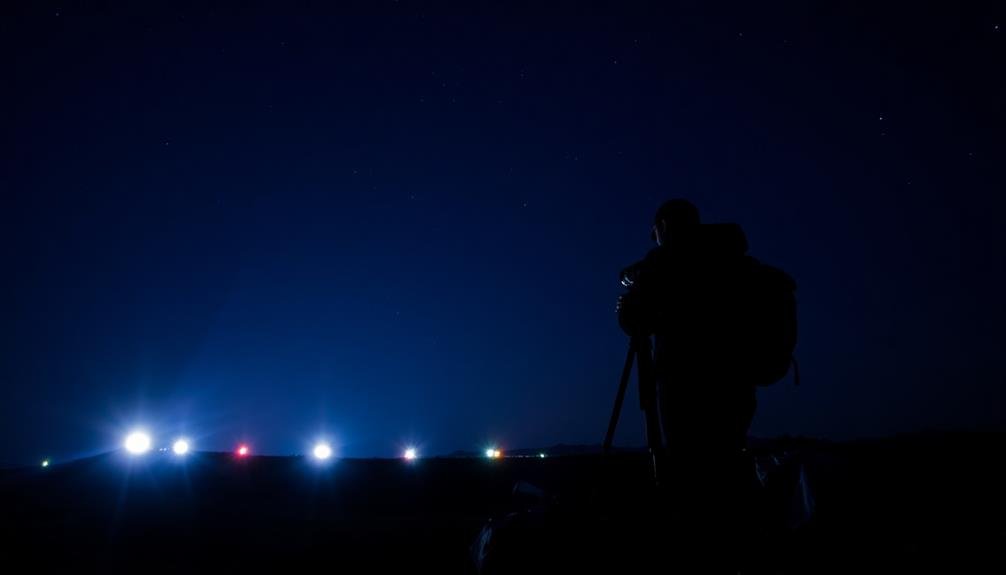
Strobe lights are the heavy hitters of anti-collision lighting for night photography. These powerful, pulsating lights grab attention instantly, making them ideal for guaranteeing your safety during nighttime shoots.
You'll find that strobe lights emit brief, intense bursts of light at regular intervals, creating a striking visual effect that's hard to miss.
When choosing strobe lights for your photography gear, consider their brightness, measured in candela. Opt for models with at least 20 candelas for maximum visibility.
Look for lights with adjustable flash rates, typically ranging from 60 to 120 flashes per minute. This flexibility allows you to adapt to different environments and regulations.
Durability is essential for outdoor use. Select weather-resistant strobe lights that can withstand various conditions.
Many modern options feature rugged construction and IP65 or higher ratings for dust and water resistance.
Battery life is another important factor. Choose lights with long-lasting batteries or rechargeable options to guarantee uninterrupted operation during extended shoots.
Some advanced models offer solar-powered options, providing an eco-friendly and convenient solution for remote locations.
Remember to check local regulations regarding the use of strobe lights, as some areas may have restrictions on their intensity or color.
LED Beacons for Long-Lasting Performance
Powerhouses of endurance, LED beacons offer a reliable and long-lasting solution for night photography safety. You'll appreciate their energy efficiency, which allows for extended use without frequent battery changes.
These lights emit a bright, steady glow that's visible from great distances, ensuring your position is easily identifiable to others in the area.
When choosing LED beacons for your night photography sessions, consider these key features:
- Battery life: Look for models that can last through your longest shoots without needing a recharge.
- Brightness options: Adjustable intensity settings allow you to adapt to different environments and lighting conditions.
- Durability: Select waterproof and shockproof beacons to withstand outdoor elements and accidental drops.
LED beacons are available in various colors, with red being a popular choice for preserving night vision.
You'll find both magnetic and clip-on options, making it easy to attach them to your gear or clothing. Some models even offer multiple lighting modes, such as steady-on, flashing, or SOS signals.
Rechargeable Anti-Collision Light Systems
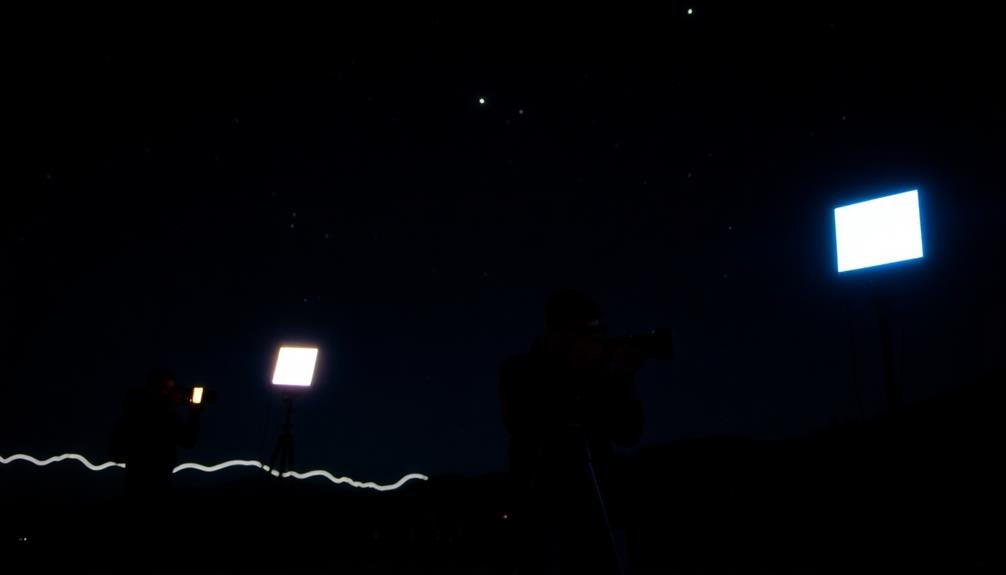
Numerous photographers are turning to rechargeable anti-collision light systems for their night shoots. These versatile devices offer several advantages over traditional battery-powered options.
You'll find that rechargeable systems provide longer-lasting illumination, reducing the need for frequent battery changes during extended sessions. Most rechargeable anti-collision lights feature high-capacity lithium-ion batteries, allowing for hours of continuous use.
You can easily recharge them between shoots using USB ports or dedicated charging stations. Many models come with multiple charging options, including car adapters and solar panels, ensuring you're never left in the dark.
When selecting a rechargeable system, consider the charging time and runtime. Top-tier options can fully charge in 2-3 hours and operate for 8-12 hours on a single charge.
Look for lights with adjustable brightness settings to conserve power when full intensity isn't necessary. Waterproof and shockproof designs are essential for outdoor use.
Opt for lights with durable housings and reliable seals to protect against the elements. Some models even float, making them ideal for marine photography or shoots near water bodies.
Compact Options for Lightweight Drones
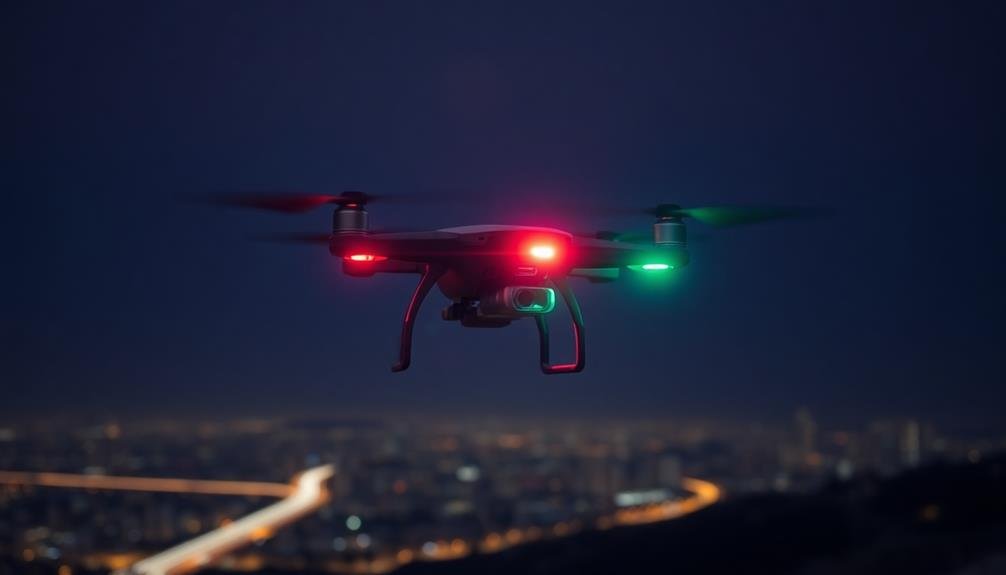
While rechargeable systems are ideal for ground-based photography, lightweight drones require a different approach. Compact anti-collision lights for drones need to balance visibility with minimal weight impact.
You'll want to look for ultra-lightweight LED options that won't compromise your drone's flight time or stability. Consider strobe lights that attach directly to your drone's body or propeller arms.
These small, powerful LEDs can be seen from great distances without adding significant bulk. Some models offer multiple color options and programmable flash patterns, allowing you to customize your drone's visibility in various conditions.
When selecting compact anti-collision lights for your lightweight drone, keep these factors in mind:
- Weight-to-luminosity ratio: Opt for lights that provide maximum brightness with minimal added weight.
- Battery life: Choose lights with long-lasting batteries to match your drone's flight time.
- Ease of attachment: Look for lights with secure, streamlined mounting options that won't interfere with your drone's aerodynamics.
Weather-Resistant Lights for Outdoor Shoots
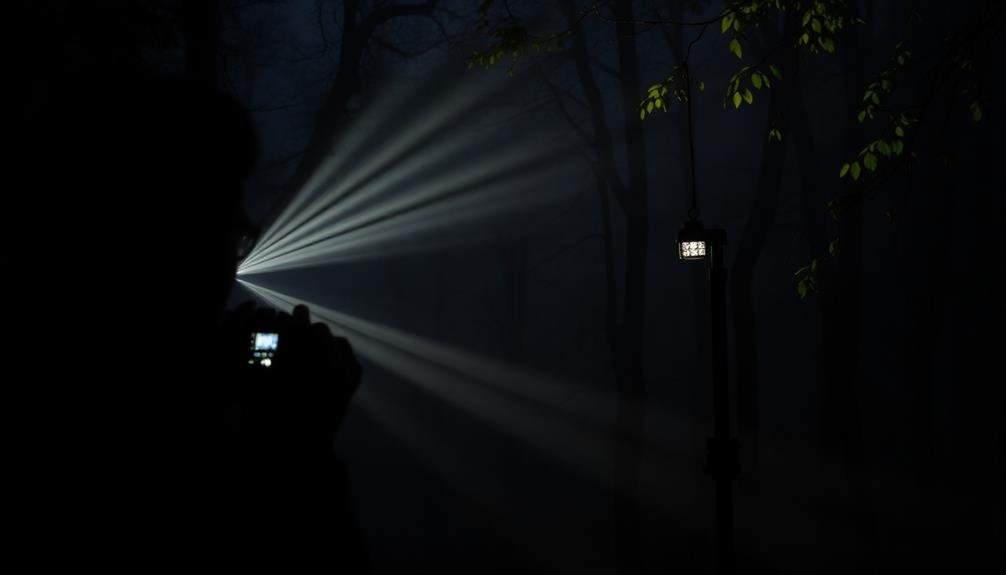
Outdoor photography demands rugged equipment that can withstand the elements. When selecting anti-collision lights for your night photography sessions, you'll need to prioritize weather resistance to guarantee reliability in various conditions.
Look for lights with high IP ratings, such as IP67 or IP68, which indicate protection against dust and water ingress. These ratings mean your lights can handle rain, snow, and even brief submersion without failing.
Consider lights made from durable materials like aircraft-grade aluminum or reinforced polymers. These materials resist corrosion and can withstand impacts from accidental drops or debris.
Sealed battery compartments are essential to prevent moisture from damaging the power source. Some models feature rubber gaskets or O-rings to create a watertight seal.
Don't overlook temperature ratings. Choose lights that can operate in both freezing and hot conditions, typically ranging from -20°C to 45°C (-4°F to 113°F). This guarantees functionality in diverse climates.
LED-based lights are often more resilient to temperature fluctuations than other types.
Lastly, check for UV-resistant coatings on the light's exterior. This feature prevents degradation from prolonged sun exposure, maintaining the light's integrity and appearance over time.
Multi-Color Lights for Versatile Use
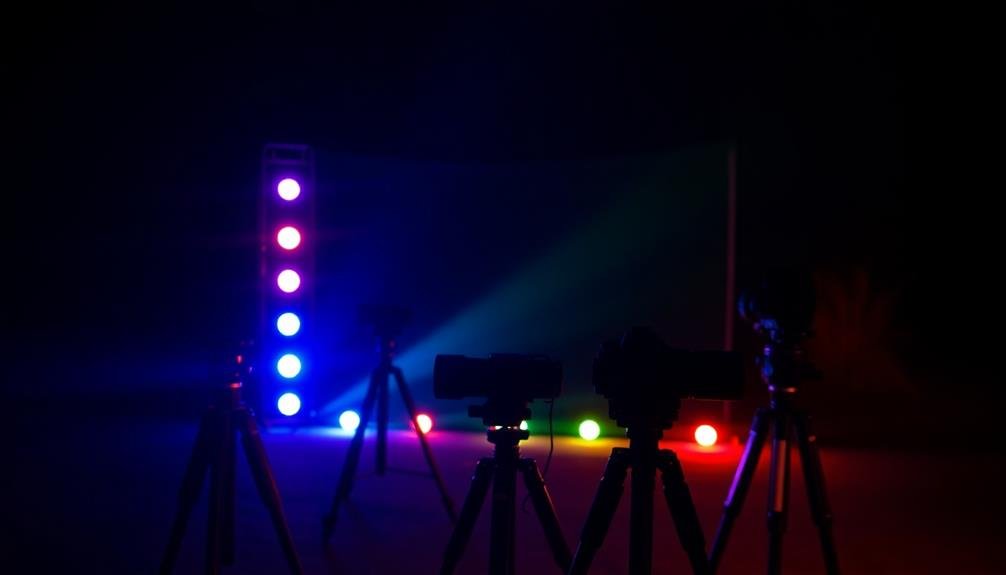
You'll find that many anti-collision lights for night photography offer color-changing modes, expanding your creative possibilities.
These versatile lights allow you to switch between different hues, creating dynamic and visually striking effects in your nocturnal shots.
Color-Changing Modes Available
Many anti-collision lights for night photography come equipped with color-changing modes, allowing photographers to switch up their lighting effects on the fly.
These versatile features enable you to adapt to different shooting scenarios without changing your equipment. You'll find lights that offer smooth shifts between colors or instant switches, giving you control over the mood and atmosphere of your shots.
When selecting anti-collision lights with color-changing modes, consider the following benefits:
- Creative freedom: Experiment with various color combinations to enhance your compositions and create unique visual effects.
- Adaptability: Quickly adjust to changing lighting conditions or client preferences without swapping out gear.
- Cost-effectiveness: Invest in a single versatile light instead of purchasing multiple single-color options.
Most color-changing lights offer a range of preset modes, including solid colors, fades, and strobes.
Some advanced models even allow you to create custom color sequences or adjust the speed of color shifts. You'll also find lights with smartphone apps that let you control color changes remotely, giving you more flexibility in your setups.
When choosing a light, pay attention to the number of available colors and the ease of switching between modes to guarantee it meets your specific photography needs.
Creative Lighting Opportunities
A wealth of creative lighting opportunities opens up when you incorporate multi-color lights into your night photography arsenal.
These versatile tools allow you to experiment with different hues and moods, enhancing your compositions and adding depth to your images.
You can use red lights to create an eerie, otherworldly atmosphere in landscape shots or to illuminate foreground elements without affecting your night vision.
Blue lights work well for simulating moonlight or adding a cool, ethereal glow to water features.
Green lights can create an alien-like ambiance or highlight foliage in nature photography.
By combining multiple colors, you'll be able to paint with light, creating unique effects and gradients in long-exposure shots.
Try using different colored lights to illuminate various parts of your subject, adding dimension and interest to portraits or still life compositions.
Don't forget about white light options, which you can use in conjunction with colored gels to achieve custom hues.
This flexibility allows you to match or contrast with existing light sources in your scene, giving you complete control over your image's color palette and mood.
Remote-Controlled Anti-Collision Light Setups

Remote-controlled anti-collision light setups offer you unprecedented flexibility in night photography.
You'll find wireless control options that allow you to adjust settings from a distance, eliminating the need to physically access each light.
Many systems also feature multi-light synchronization, enabling you to coordinate multiple units for complex lighting scenarios.
Wireless Control Options
Photographers' workflow can be greatly streamlined with wireless control options for anti-collision lights in night photography. You'll find various systems available, from simple remote controls to sophisticated smartphone apps.
These wireless options allow you to adjust light settings, activate strobes, and even change colors without physically approaching the lights.
When choosing a wireless control system, evaluate compatibility with your existing equipment. Many manufacturers offer proprietary systems that work seamlessly with their own lights.
However, universal options are also available for those using mixed setups.
Key advantages of wireless control include:
- Increased safety, as you won't need to navigate dark terrain to adjust lights
- Improved efficiency, allowing quick adjustments without interrupting your shoot
- Enhanced creativity, enabling real-time experimentation with different lighting scenarios
Range is an important factor to evaluate. While most systems work well within 100 feet, some high-end options offer greater distances.
Battery life is another vital aspect, especially for extended night shoots. Look for systems with long-lasting batteries or those that can be easily recharged in the field.
Ultimately, the right wireless control option will depend on your specific needs, budget, and existing equipment.
Multi-Light Synchronization Features
With multi-light synchronization features, you can take your night photography to the next level. These advanced systems allow you to control multiple anti-collision lights simultaneously, creating complex lighting setups for your nocturnal shoots. You'll have the power to adjust brightness, color, and flash patterns across all connected lights with a single command.
Most high-end anti-collision lights offer built-in synchronization capabilities, typically using radio frequency (RF) or Bluetooth technology. You can group lights together and control them as a single unit or manage them individually within the same network. This flexibility enables you to create dynamic lighting effects, such as sequential flashing or coordinated color changes.
Some systems even allow you to program custom lighting sequences, giving you unprecedented creative control over your night photography environment. You'll find that synchronized lights can help you illuminate larger areas more effectively, capture unique long-exposure shots, or add depth to your compositions by strategically placing and controlling multiple light sources.
When choosing a multi-light system, consider factors like range, number of supported lights, and compatibility with your existing equipment. Look for systems that offer intuitive interfaces and robust connectivity to guarantee smooth operation during your shoots.
High-Intensity Lights for Extended Range
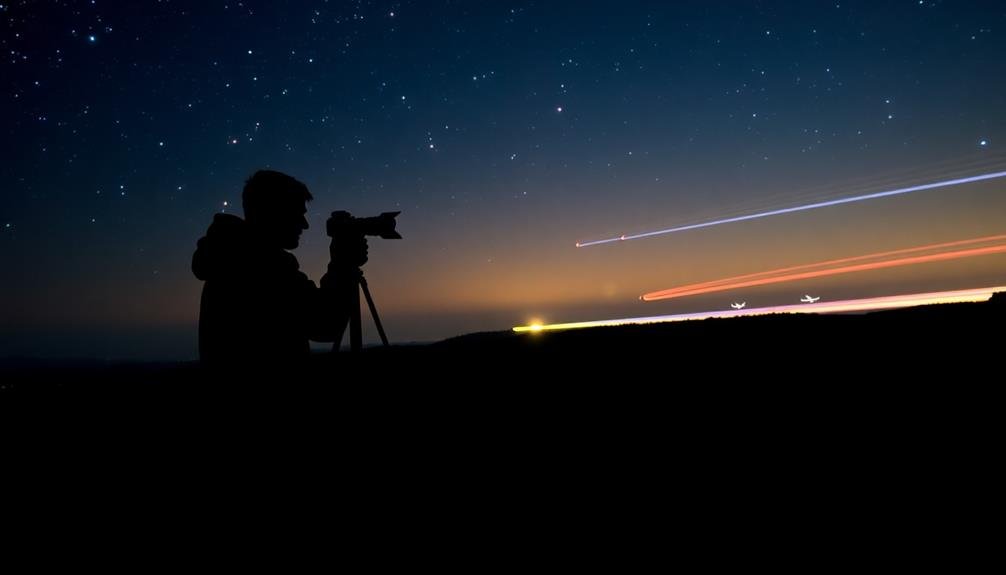
High-intensity lights are essential for night photographers who need to illuminate subjects at greater distances. These powerful beams can cut through darkness, allowing you to capture crisp images of wildlife, landscapes, or architectural features that might otherwise be lost in the gloom.
When selecting high-intensity lights for your night photography sessions, you'll want to weigh factors such as beam distance, battery life, and color temperature.
Look for lights with adjustable brightness settings, as this flexibility will help you adapt to various shooting conditions. LED technology has revolutionized high-intensity lighting, offering improved energy efficiency and longer-lasting illumination compared to traditional bulbs.
Some models even feature remote control capabilities, allowing you to adjust settings without disturbing your camera setup.
Here are three key benefits of using high-intensity lights for extended range:
- Increased visibility of distant subjects
- Reduced noise in low-light images
- Greater creative control over lighting composition
Remember that while high-intensity lights can dramatically improve your night photography, they may also disturb wildlife or interfere with other photographers.
Always use these powerful tools responsibly and be mindful of your surroundings when setting up your shots.
FAA-Compliant Anti-Collision Light Models
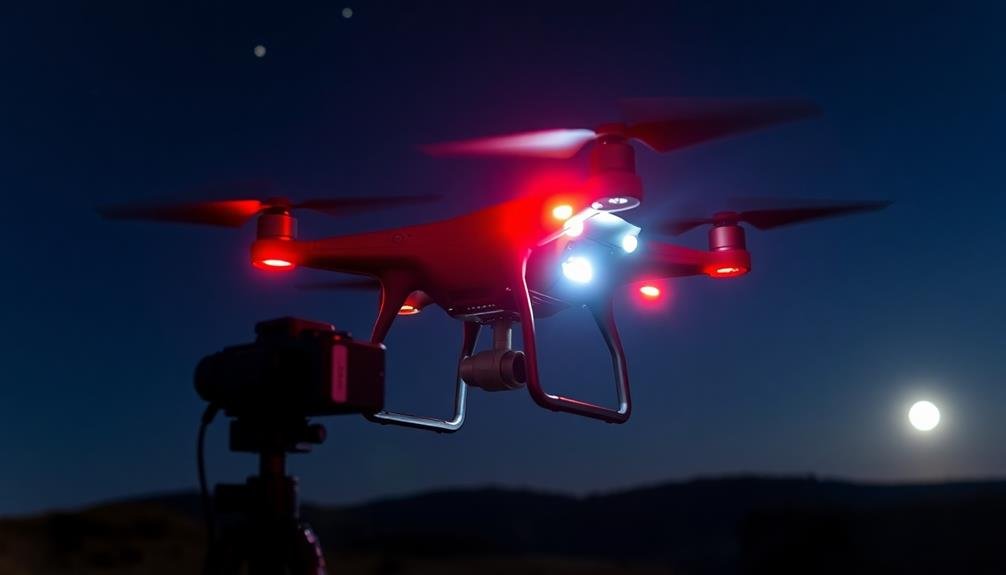
When selecting FAA-compliant anti-collision lights for night photography, you'll find several top-approved options that meet stringent safety standards.
These models feature specific compliance elements, including proper light intensity, flash rates, and color requirements mandated by aviation regulations.
To guarantee proper usage, you'll need to familiarize yourself with correct installation procedures and operational guidelines for your chosen light system.
Top Faa-Approved Light Options
Photographers seeking FAA-compliant anti-collision lights for night shoots have several excellent options to choose from.
The FoxFury Nomad Prime is a popular choice, offering 360-degree visibility and multiple light modes. It's compact, waterproof, and provides up to 24 hours of battery life.
Another top contender is the Lume Cube Strobe, which attaches easily to drones and offers a lightweight solution with adjustable flash rates.
For those prioritizing durability, the FireHouse Technology ARC Drone Strobe is an excellent pick. It's designed to withstand harsh conditions and provides bright, long-lasting illumination.
When selecting an FAA-approved light, consider these key factors:
- Visibility range: verify the light is visible from at least 3 statute miles away
- Flash rate: Look for lights with adjustable flash rates to meet FAA requirements
- Battery life: Choose a light with sufficient battery life for your planned flight duration
Compliance Features Explained
Understanding the specific compliance features of FAA-approved anti-collision lights is key to ensuring your night photography setup meets regulations. These lights must meet strict visibility and performance standards to be considered compliant.
Look for lights that offer 360-degree visibility, as this is a vital requirement. The FAA mandates that anti-collision lights must be visible from at least 3 statute miles away in clear night conditions.
Color is another important factor. FAA-compliant lights typically come in red or white, with specific intensity requirements for each. Red lights must have an effective intensity of at least 40 candelas, while white lights need a minimum of 400 candelas. Many modern LED-based anti-collision lights exceed these requirements, offering enhanced visibility.
Pay attention to the light's flash rate as well. Compliant models should flash between 60 to 240 times per minute. Some advanced models offer adjustable flash patterns, allowing you to customize the light's behavior while staying within regulations.
Additionally, check for weather resistance ratings, as these lights must function reliably in various environmental conditions. By understanding these compliance features, you'll be better equipped to choose the right anti-collision light for your night photography needs.
Installation and Usage Tips
Setting up FAA-compliant anti-collision lights for night photography can be straightforward if you follow some key installation and usage tips.
When installing your lights, make certain they're securely attached to your gear or tripod. Most models come with various mounting options, including clamps, straps, or threaded attachments. Choose the method that best suits your equipment and shooting conditions.
Position your lights for maximum visibility. They should be unobstructed and visible from all angles, typically at the highest point of your setup. If you're using multiple lights, space them evenly to create a clear perimeter around your photography area.
Here are three important usage tips to remember:
- Activate your lights before sunset and keep them on until sunrise
- Regularly check battery levels and carry spares for extended shoots
- Familiarize yourself with your light's different modes and select the appropriate one for your location
Always comply with local regulations and obtain necessary permits for night photography sessions.
Be mindful of your surroundings and avoid disturbing wildlife or other photographers.
Dual-Purpose Lights for Navigation
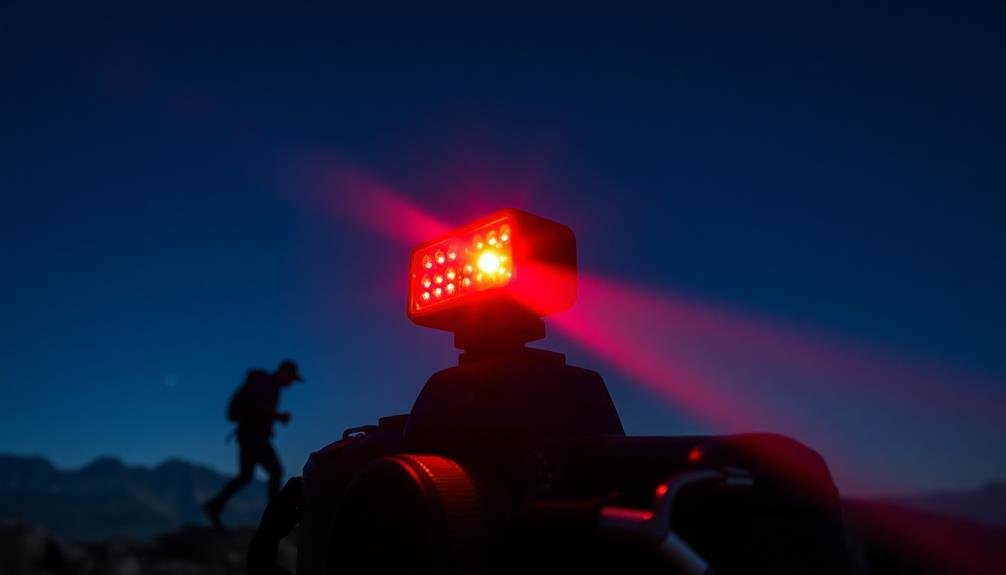
Beyond their role in night photography, anti-collision lights serve an important dual purpose for navigation. When you're moving equipment or crew members in low-light conditions, these lights help prevent accidents and guarantee everyone's safety. They're particularly useful when you're working in remote locations or on uneven terrain.
You'll find that many anti-collision lights come with multiple modes, allowing you to switch between photography and navigation functions easily. Here's a comparison of popular dual-purpose lights:
| Model | Battery Life | Visibility Range | Modes | Waterproof Rating |
|---|---|---|---|---|
| LumiPro X200 | 12 hours | 2 miles | 5 | IP67 |
| PhotoBeam 3000 | 8 hours | 1.5 miles | 3 | IP65 |
| NightGuard Pro | 10 hours | 1.8 miles | 4 | IP68 |
| SafeShot Beacon | 15 hours | 2.2 miles | 6 | IP66 |
| VisualAlert 500 | 9 hours | 1.7 miles | 4 | IP67 |
When choosing a dual-purpose light, consider factors like battery life, visibility range, and durability. Opt for models with extended battery life if you're planning long shooting sessions. Higher visibility ranges are vital for open areas, while multiple modes offer flexibility for various scenarios. Don't forget to check the waterproof rating for outdoor use in different weather conditions.
Frequently Asked Questions
How Do Anti-Collision Lights Affect the Quality of Night Photographs?
Anti-collision lights can impact your night photos by introducing unwanted light sources. They'll create bright spots or streaks in your images, potentially washing out details and altering the overall mood you're trying to capture in low-light conditions.
Can Anti-Collision Lights Interfere With Other Electronic Equipment During Photography Sessions?
Yes, anti-collision lights can interfere with other electronic equipment. They may cause electromagnetic interference, affecting your camera's sensors or nearby devices. It's best to keep them at a safe distance from sensitive equipment during your photography sessions.
Are There Any Specific Mounting Techniques for Anti-Collision Lights on Cameras?
You'll find several mounting options for anti-collision lights on cameras. You can use hot shoe adapters, brackets, or custom rigs. Don't forget to secure them tightly and balance the weight to avoid affecting your camera's stability.
What Are the Power Consumption Differences Between Various Types of Anti-Collision Lights?
You'll find LED anti-collision lights consume the least power, followed by xenon strobes. Incandescent bulbs use the most energy. Consider battery life when choosing; LEDs can last hours, while others might drain batteries quickly.
How Do Anti-Collision Lights Perform in Extreme Temperatures During Night Shoots?
You'll find that most anti-collision lights perform well in extreme temperatures. They're designed to withstand harsh conditions. However, you should check the manufacturer's specifications, as some may have reduced battery life or brightness in extreme cold or heat.
In Summary
You've now explored the top anti-collision lights for night photography with drones. Whether you're looking for high-intensity strobes, long-lasting LEDs, or compact options, there's a light that'll fit your needs. Remember to prioritize visibility, battery life, and FAA compliance when making your choice. With the right anti-collision light, you'll enhance your drone's safety and capture stunning nighttime shots. Don't let darkness limit your creativity – light up the night sky!

As educators and advocates for responsible drone use, we’re committed to sharing our knowledge and expertise with aspiring aerial photographers.




Leave a Reply